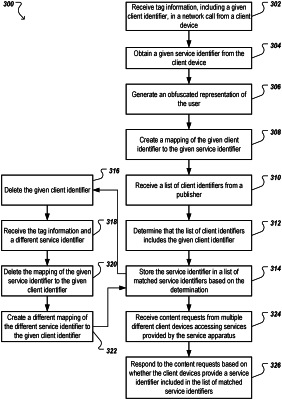| CPC H04L 67/14 (2013.01) [G06F 21/31 (2013.01); H04L 63/10 (2013.01); H04L 67/02 (2013.01)] | 20 Claims |

|
1. A method, comprising:
receiving, by a service apparatus and from a publisher, a list of client identifiers representing a plurality of users that the publisher has selected to be recipients of user-specific information, wherein the list of client identifiers include a first client identifier that is assigned to a first user by the publisher, and wherein:
the service apparatus is in a second level Internet domain that is outside of a different second level Internet domain of the publisher; and
the publisher differs from each of (i) the service apparatus and (ii) the first user;
receiving, by the service apparatus from a first client device of the first user, a first request for the user-specific information, the first request having a first service identifier that is assigned to the first user by the service apparatus, wherein the first service identifier for the first client device is different than the first client identifier;
accessing, by the service apparatus, an identifier mapping, wherein the identifier mapping includes a mapping of the first service identifier to the first client identifier;
determining, by the service apparatus, that the first client device has access to the user-specific information based on the mapping of the first service identifier to the first client identifier in the identifier mapping; and
transmitting, by the service apparatus to the first client device, the user-specific information in response to the determination that the first client device has access to the user-specific information based on the mapping of the first service identifier to the first client identifier in the identifier mapping.
|